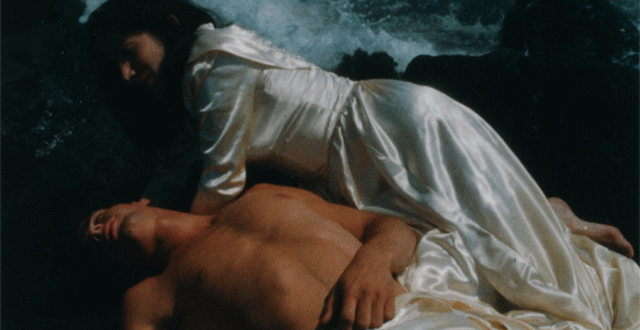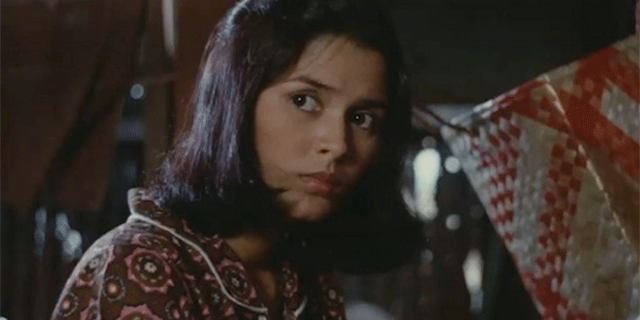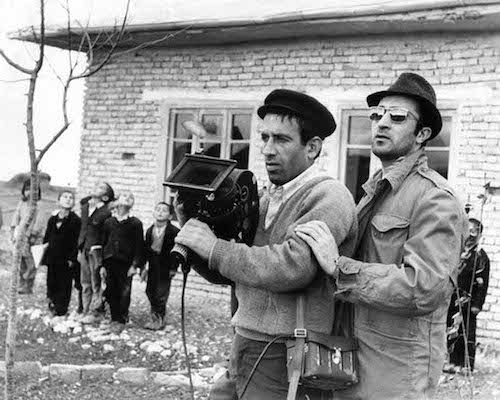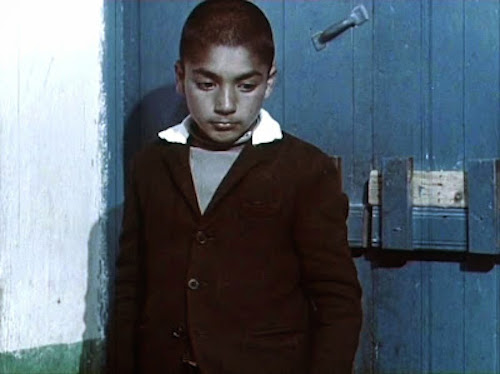Suddenly, I realised that this film was impregnated with the gaze of cinema goers from the time of the Occupation – people from all walks of life, most of whom would not have survived the war. They had been taken out of themselves after having seen the film one Saturday night, their night out. While it lasted, you forgot the war and the menacing world outside. Huddled together in the dark of a cinema, you were caught up in the flow of images on the screen, and nothing more could happen to you. And, by some chemical process, this combined gaze had altered the very substance of the film, the lighting, the voices of the actors.
This awareness of something special that seems to happen to a film over its life comes from 2014 Nobel Prize winning author Patrick Modiano’s The Search Warrant. (1) The narrator senses this aura when he is watching a film made many years before, and in a completely different world.
Usually, viewers at film festivals savour the fact that they are seeing a film that has not yet been impregnated by the gaze of other cinema-goers, that it is a virgin experience. But at Bologna’s Il Cinema Ritrovato Festival the anticipations are different. Its audience knows it is seeing films that have absorbed the responses of some generations of film-goers, or that have suffered perhaps from years of neglect or loss, that have been witness to events of major international, political or cultural significance, or it’s something they saw long ago, perhaps when it was actually on release. This festival gives those films a chance to come alive again, to become part of the experience of new generations of film viewers.
Not all the films have become unknown – many are still vividly kept alive in history books, or in the memories of older festival-goers. But quite a few have suffered physically from the passage of time, of physical deterioration. Some have been believed lost forever. The Cineteca di Bologna plays a significant role in retrieving the past life of the cinema. Its laboratories, L’Immagine Ritrovato have become a widely recognised standard setter in the field of film restoration. Recently a new branch has been established in Hong Kong that will contribute to the restoration of Asian cinema history in the years to come.
Il Cinema Ritrovato is its annual festival, presenting recent rediscoveries and restorations and other films from international archives. Program curation highlights important technical or technological aspects, social, historical and cultural contexts, and individual significant films and restorations. This year’s event was the 29th edition.
It is easy for restorations of high-power films to hog the spotlight. Casablanca (Michael Curtiz, 1942) or 2001: A Space Odyssey (Stanley Kubrick, 1968) do not really have to justify the value of their being restored and re-presented in the best possible condition. But a film like Insiang (Lino Brocka, 1976) has to fight to regain its public recognition. Il Cinema Ritrovato screened a new restoration that more than eloquently made the case for its cultural worth, and the value of expensive new laboratory work.
Brocka, openly gay and critical of the Filipino political regime, always had a struggle to make his films. Insiang is a study of a young woman surviving in the slums, an environment that sucks humanity and joy out of its dwellers. The powerful opening sequence in an abattoir establishes the milieu and sets up its audience for a powerful confronting experience. It is still as uncomfortable as it is no doubt was for Filipino society at the time. Lino Brocka described his films as “first and foremost a character analysis: a young woman raised in a miserable neighbourhood. I need this character to recreate the ‘violence’ stemming from urban overpopulation, to show the annihilation of a human being, the loss of human dignity caused by the physical and social environment and to stress the need of changes (in) these life conditions.” (2)
The new print screened in Bologna is a triumph of film restoration, completed this year as part of the Martin Scorsese supported World Cinema Project. This project is rediscovering and restoring significant films from beyond the usual sphere of Hollywood and commercial filmmaking. It has already restored works from Asian, African and other Third World filmmakers. Insiang is on YouTube in a muddy, pallid copy. But the restoration is sharp, and rich, showing how Brocka exploited the technology he had to explore this world, and used two colour palettes to enrich his themes. There is the dirty, dun-inflected yellow, the colour of the slums, the dirt, the lack of any vegetation or other natural beauty where people are forced to live. Then splashing through this comes the shock of the manufactured colours, the electric pinks and purples and greens the shanty residents have chosen in attempts to brighten their lives – a T-shirt, a plastic utensil, a tablecloth.
Two other beautiful World Cinema Projects restorations raised a different question. Given that film restoration is expensive and time consuming how do you decide on what films to restore? Ousmane Sembène’s La Noire de… (Black Girl, 1966) is a significant film for African Cinema and in Sembène’s career. Again focussed on a young woman, a Senegalese who takes a job as governess with a French family but finds herself reduced to little more than a maid. The film’s style is simple – at times almost to the simplistic – but always vibrantly cinematic, a single crisp black-and-white image revealing the always-present colonial, racial attitudes she faces. As with any strong piece of work, the fashions may date it, but not the emotions, the insights, the urgency. Clearly this is a work justifying restoration.
I was more ambivalent about Alyam Alyam (Oh, the Days Ahmed El Maanouni 1978). One of a number of films emerging from Morocco in the 1970s, it was the first to be directed by El Maanouni. Its protagonist is a young man who is expected to become head of his family when his father dies. El Maanouni has said, “I simply wanted to show the farmers’ faces, to honor their sounds and their images, their silences and their words, and that’s why I chose not to interfere and to opt for deliberately restrained composition and mise-en-scène.” (3) But to me it was so “restrained” that it was as though there was no sign of any cinematic involvement. Scenes were unstructured, with no clear purpose. Any interest was so parochial it amounted to little more than an example of Moroccan filmmaking of this period. Were there other films from this region and period that were more worthy of preservation, or of more relevance outside the immediate home territory?
A related programming strand highlighted several films of the “birth of Iranian New Wave Cinema”, when a number of filmmakers returned to Iran in the years before the Iranian Revolution overthrew the Shah in 1979 after periods abroad. Several of these filmmakers were to have a significant impact on Iranian cinema. Since that period, Iran has made some of the richest contributions to world cinema, and the precursors of this era certainly justify attention.
The selection gave a clear idea of from where the exciting cinema of Kiarostami, Makhmalbaf and their contemporaries would later emerge. Shab-e Ghuzi (The Night of the Hunchback, Farrokh Ghaffari 1965), adapted from a story in the original One Thousand and One Nights collection of stories, could be the lost cousin of Hitchcock’s The Trouble With Harry (1955) as a group of stage actors spend a frantic night trying to dispose of a corpse. As a piece of storytelling it is not very sophisticated or effective. Events are too obviously planted rather than evolving from character or situation, the acting is resolutely indifferent, and the structure is more amateur theatrics than cinematic. The film was not a commercial success at the time of its release, but is seen by many writers as a “turning point in Iranian cinema.” It is reputed to have provided an inspiration for later Iranian filmmakers that cinema could be a means of political and social criticism.
Kamran Shirdel’s Oon shab ke baron oomad ya hemase-ye roosta zade-ye Gorgani (The Night It Rained Forever, or the Epic of the Gorgan Village Boy, 1967) is ostensibly a documentary. But it is a much freer ramble on the form of documentary and media and journalism. On the surface it is about a heroic village boy valorised for saving over 200 lives when he stopped a train in danger of disaster after rain washed away the tracks. Shirdel used an almost tabloid approach to explore the reporting of the incident, the event itself, and questions of responsibility (and officials ducking accountability) with strong hints of official culpability. Using newspaper headlines, “talking head” interviews (intercutting two different versions from time to time), and new footage shot in the village by his camera crew it has some of the energy of Errol Morris’ much later Tabloid (2010) but it goes much further in the breadth of its interests, and is still an exciting piece of filmmaking.
Yek Ettefagh-e sadeh (A Simple Event, 1973) directed by Sohrab Shabid Saless is even more an intimation of Iranian films to come, and in particular the early films of Abbas Kiarostami. This quiet and seemingly undramatic film contemplates the life of a boy living by the Caspian Sea. This is not an idealised childhood. There are no moments of escapades, or games, or fun. One moment follows another moment in an emotionless parade. Getting up, breakfast, errands and chores, school (where he is not too bright, and doesn’t seem to have a circle of friends), more chores on the way home from school including selling the fish his father has caught. Into this almost numbing procession of events there is one “simple event.” His mother dies.
This “simple” life is observed with a quiet, dispassionate gaze that at the same time is saying this is a life worth observing, because it simply is a life. There is also a degree to which this quiet observation is saying so much more about life and society in Iran, and by extension the whole world, than any polemical piece of filmmaking. Its time spent with a child is a foretaste of the films not too far in the future from filmmakers such as Abbas Kiarostami (Khane-ye doust kodjast / Where is the Friend’s Home?, 1987), Jafar Pahahi (Badkonake sefid / The White Balloon, 1995) or Majid Majidi (Rang-e Khodā / The Color of Paradise, 1999).
For the last three years, Il Cinema Ritrovato has explored the experience of filmgoing in Japan at the time of the transition to sound. This year saw the launch of a planned three year look at films from the introduction of colour into filmmaking in Japan. Along with another Ritrovato strand looking at selected Technicolor prints from elsewhere in the world, this approach highlights the relevance of looking at the relationship between various technological developments in Cinema, and audience responses and artistic and expressive possibilities for filmmakers.
Two restorations demonstrated how good restorations can bring a film back to life. Kenji Mozoguchi’s Shin Heike Monogatari (Tales of the Tara Clan, 1955) was presented in a beautiful digital restoration. It is cinema’s loss that Mizoguchi made only two films in colour.
Japan’s filmmaking industry had been preparing for the introduction of colour even while World War II was raging. Because its cinemas needed only 10 to 20 prints even for a major film, the technical demands were different to America’s, where at that time up to 150 prints could be needed. This difference made reversal prints a possibility in Japan, whereas in USA Technicolor’s dye transfer process was more workable for Hollywood. But both processes produce different aesthetic results – and, sadly, original colour tonings can be lost in insensitive digital restorations.
Shin Heike Monogatari exploits the rich delicate shades of bright silk embroidered kimonos, or massed cherry blossom trees, or angry reds and blacks for scenes of conflict and dramatic action. Throughout, the colour is used to enrich the mood and tone of this famous Japanese historical tale of a time of civil war between two rival clans.
Gate of Hell (Jigokumon, Teinosuke Kinugasa 1953) was not particularly well received by domestic audiences on its release, but it stormed through the West, including being honoured at the Cannes Film Festival and the Academy Awards. Filmed using imported Eastmancolor stock, it was its use of colour which so amazed Western audiences then – and now. Previously, I have only seen this film in perfectly adequate commercial prints, and I have been rather indifferent to this story of an impetuous love that destroys the object of its desire, when an heroic samurai, as a reward for his valiant defence of his lord, asks for the beautiful woman he has seen. But she is married – and faithful to her husband.
In this beautiful restoration, kimonos shimmering with their richness, skin luminescent, trees and flowers vibrant with life, the film re-acquires a depth and meaning that must have been there for the original audiences.
By contrast other films in this strand showed the effect of unsatisfactory restorations. The problem of colour prints fading to magenta is well known. But Eastmancolor negatives can also lose colour, and need restoration to regain the original colour. Sadly, several other films from this period were presented in newly minted prints – but from unrestored and faded negatives.
Ejima Ikushima (Ejima and Ikushima, Hedeo Oba, 1955) belongs to the tradition of historical court dramas, with a story familiar to Japanese audiences of an episode from Edo-period Japan. A Court Lady causes a scandal when she breaks a taboo, and visits a Kabuki performance. This sets off a chain of events with tragic outcomes. In its time, a highly successful film, the print on view today does it no justice. Whites in particular have turned to a jaundiced yellow, leaving the healthiest character looking sick, and depriving the rich silks of the contrasts that sets off their lushness. This deprivation of an important element of the film’s aesthetic is alienating for today’s audience, leaving a thinness in the film’s psychology. The stylised performance style feels flat and disengaging, rather than effective.
Hotaru No Hikari (The Firefy’s Glow, Kazuo Mori, 1955) was another film that suffered from this problem of an unrestored negative. This is a contemporary story, a sympathetic portrait of a young woman trying to sustain her family’s traditional business after the death of her parents. That business is creating patterns for kimonos, a wonderful opportunity for the colour camera. But it is the colour that has suffered most from the unrestored negative. Again, without the seduction (or distraction) of rich colour, what remains comes through now as a rather soft, sentimental film without the depth of involvement and compassion that Mikio Naruse would have brought to the story.
Il Cinema Ritrovato explored many other aspects of cinema’s history. I was sorry that a crowded schedule meant that I saw nothing in the program strand, Silence of 1915 and Armenian cinema. The Armenian genocide of 1915 has been almost ignored or denied by much of the world. Only a handful of films have touched on it – one of the few films being La masseria delle allodole (The Lark Farm, Taviani Bros, 2007). The programs on offer at Bologna promised to give life back to actual documentary footage from 1911-18, testimony to the power of cinema to bear witness, to carry forward the soul of people and events from the past.
The event presentation of Rapsodia Satanica (Satanic Rhapsody, Nino Oxilia, 1915-17) also allowed the audience of 2015 to imagine itself back a hundred years. For this to happen, elements seemingly lost or separated over the years needed to be re-united again. Nino Oxilia was a young Italian director of promise, who made several “diva” films, wonderful melodramas of women and the tribulations they face because of passion. His career was cut short in 1917 when he was killed in World War I. Il Cinema Ritrovato screened another of his films, Sangue Bleu, last year. (4) Perhaps today it is hard to take the story of Satanic Rhapsody too seriously. A wealthy woman, aware that she is no longer as young as she once was, makes her Faustian pact with the Devil to have her youth restored. Lydia Borelli, who plays the woman, is a true Diva, with an imposing screen presence.
The film has been circulating as a pale grey-and-white ghost of itself on YouTube, but this is like all the life and personality has been drained from it. When the film was first presented one hundred years ago, it was accompanied by a special score. Recently this score was discovered, double an important discovery because not only is the score one of the very first written specifically to accompany a film, but it was written by a major Italian composer, Pietro Mascagni (Cavalleria rusticana). Then a very special print was discovered, one using stencil colouring, rather than toning and imbition. From this a new print was struck for a presentation in the beautiful opera house in Bologna, with the score played by L’Orchestra del Teatro Comunale di Bologna. The stencilling approach allowed for a greater use of colour than was general at that time, where a whole scene would be tinted in an appropriate shade – blue for night scenes, for example. With this particular elements could be picked out. The diva’s dress was a delicate shade of purple, the devil a vivid red. So, we had a wonderful venue, an excellent orchestra playing a very interesting score, and a rip-roaring melodrama with added allure from its new colour coat – the combination from which permanent cinematic memories are created.
But there was one more special film that has so far been seen by too few viewers to be impregnated directly with their beings – but which absolutely radiated with the essence of filmmakers, viewers, and all humanity. Made in 1982, Manoel de Oliveira’s Visita ou memórias e confissões (Visits or Memories and Confessions) has only been released since his death in April this year, at the age of 106. An intensely personal film, he didn’t want to be seen as self-indulgent or blowing his own trumpet, so he embargoed it until he had died. He was already over 70 when he made it, and no doubt did not expect to live another 33 years – or to make another 42 features, shorts and documentaries.
In 1982, he had been forced to sell the house that had been his family’s home for over four decades, a home alive with the memories, the spirit of generations of his family, and of his own married life. But his “memories and confessions”, after all, cover a lifetime, political regimes including the Salazar dictatorship, religion, cinema, history. Technically, it is a simple film – no elaborate tracking shots, or complicated photographic or editing devices, often basic, long held shots of a room, or a window, or an oleander bush in bloom.
At one level, Visita is so personal, you’d imagine it would mean something to his close immediate family. Or at least to cinephiles who have seen his work over the years. But it is redolent of so much understanding, of so much compassion and empathy, of so much human experience. Because I have been “following” Oliveira’s career from about the time he made Visita it was like having one last meeting with a beloved old friend.
I did wonder, however, how this film from a septuagenarian would connect with the latest generation of cinephiles. One of the joys of Bologna is that there are so many of these new filmlovers, many still in the final years of study. Some are seeing 2001: A Space Odyssey or Goodfellas (Martin Scorsese, 1990) for the first time during the Festival. It was wonderful to talk to some of them, who in fact had not yet seen any other films by de Oliveira – and they loved it. Its simple humanity also spoke to them.
So, now Visita sets out on its journey to film lovers around the world and for years to come, who will leave the imprint of their own experiences and spirit on this film.
Il Cinema Ritrovato
27 June – 4 July 2015
Festival website: http://www.cinetecadibologna.it/en/
Endnotes
1. Patrick Modiano, The Search Warrant translated from the French by Joanna Kilmartin, Harvill Secker 2014. Original French title, Dora Bruder. Modiano is also the screenwriter of Louis Malle’s Lacombe, Lucien (1974).
2. Il Cinema Ritrovato xxix edizione Festival Catalogue Bologna 2015.
3. ibid.













